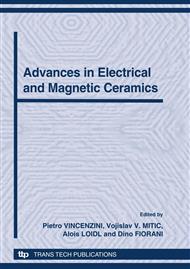p.134
p.143
p.149
p.158
p.164
p.170
p.176
p.182
p.192
Synthesis of Bi6Fe2Ti3O18 Aurivillius Phase by Wet Chemical Methods
Abstract:
The Aurivillius phases in the Bi-Fe-Ti-O system showing multiferroic properties arouse an increasing interest due to their wide potential applications in electronics. These compounds were usually prepared by high temperature solid-state reaction method using respective oxide powders mixed in required stoichiometry. An excess of bismuth oxide was often added due to its evaporation during heat treatment. The mixture of the oxide powders were calcined in air between 700 and 900°C for several or even for several dozen hours. In the present paper the Bi6Fe2Ti3O18 Aurivillius phase was prepared by direct solid state reaction between respective oxides and by co-precipitation – calcination method. Mixture of the oxides and co-precipitated gels were calcined at different temperatures and X-ray diffraction analysis was used for identification of phase composition of the products.
Info:
Periodical:
Pages:
164-169
Citation:
Online since:
October 2010
Authors:
Price:
Сopyright:
© 2010 Trans Tech Publications Ltd. All Rights Reserved
Share:
Citation:


